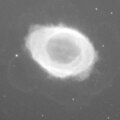File:Ring Nebula, M57 (NGC 6720) (noao-n6720).jpg
From Wikimedia Commons, the free media repository
Jump to navigation
Jump to search
Ring_Nebula,_M57_(NGC_6720)_(noao-n6720).jpg (400 × 400 pixels, file size: 53 KB, MIME type: image/jpeg)
File information
Structured data
Captions
Captions
This is a two-minute exposure taken on the night of September 26th 1994 (UT of observation 27/09/94:04:21). This photograph shows a region 150 arc seconds square.
Summary
[edit]| DescriptionRing Nebula, M57 (NGC 6720) (noao-n6720).jpg |
English: This is a two-minute exposure taken on the night of September 26th 1994 (UT of observation 27/09/94:04:21). This photograph shows a region 150 arc seconds square. The black-and-white images have been compressed in brightness (approximately a double logarithm) to show both bright and faint features. Alternatively, the pseudo-color version of the same original is used to show more of the fainter features while not saturating the bright regions. Although sky conditions were not the best that Kitt Peak can offer, this image has a "seeing" measurement (average FWHM of several stars) of about 0.8 arc seconds. The image has not been re-oriented to remove either the CCD orientation or the field rotation of the altitude-azimuth design of the WIYN telescope, and is therefore shown with E up and S to the left. About this object The Ring Nebula, also known as M57 or NGC 6720, is found in the constellation Lyra. A spherical shell of glowing gas surrounds a central hot star. The nebula was formed when the central star ejected perhaps as much as ten percent of its mass, over a period of some millions of years. Initially slow mass loss creates a surrounding shell of material which is later ionized by hotter, faster ejecta, which can result in quite complex structures. The Ring Nebula was the first planetary nebula discovered, so called because of its visual spherical appearance through telescopes in the past. It has a diameter a little under one light-year and is some 3000 light-years from Earth (angular size 1.2 arc minutes). Location: 18 53.6 +33 02 (2000) |
| Date | 30 June 2020, 21:34:00 (upload date) |
| Source | Ring Nebula, M57 (NGC 6720) |
| Author | WIYN/NOIRLab/NSF |
| Other versions |
|
Licensing
[edit]This media was created by the National Optical-Infrared Astronomy Research Laboratory (NOIRLab).
Their website states: "Unless specifically noted, the images, videos, and music distributed on the public NOIRLab website, along with the texts of press releases, announcements, images of the week and captions; are licensed under a Creative Commons Attribution 4.0 International License, and may on a non-exclusive basis be reproduced without fee provided the credit is clear and visible." To the uploader: You must provide a link (URL) to the original file and the authorship information if available. | |
This file is licensed under the Creative Commons Attribution 4.0 International license.
| |
File history
Click on a date/time to view the file as it appeared at that time.
| Date/Time | Thumbnail | Dimensions | User | Comment | |
|---|---|---|---|---|---|
| current | 18:57, 17 September 2023 |  | 400 × 400 (53 KB) | OptimusPrimeBot (talk | contribs) | #Spacemedia - Upload of https://noirlab.edu/public/media/archives/images/large/noao-n6720.jpg via Commons:Spacemedia |
You cannot overwrite this file.
File usage on Commons
The following page uses this file:
Metadata
This file contains additional information such as Exif metadata which may have been added by the digital camera, scanner, or software program used to create or digitize it. If the file has been modified from its original state, some details such as the timestamp may not fully reflect those of the original file. The timestamp is only as accurate as the clock in the camera, and it may be completely wrong.
| Image title |
|
|---|---|
| Credit/Provider | WIYN/NOIRLab/NSF |
| Source | NSF's NOIRLab |
| Short title |
|
| Usage terms |
|
| Date and time of data generation | 21:34, 30 June 2020 |
| JPEG file comment | This is a two-minute exposure taken on the night of September 26th 1994 (UT of observation 27/09/94:04:21). This photograph shows a region 150 arc seconds square. The black-and-white images have been compressed in brightness (approximately a double logarithm) to show both bright and faint features. Alternatively, the pseudo-color version of the same original is used to show more of the fainter features while not saturating the bright regions. Although sky conditions were not the best that Kitt Peak can offer, this image has a "seeing" measurement (average FWHM of several stars) of about 0.8 arc seconds. The image has not been re-oriented to remove either the CCD orientation or the field rotation of the altitude-azimuth design of the WIYN telescope, and is therefore shown with E up and S to the left. About this object The Ring Nebula, also known as M57 or NGC 6720, is found in the constellation Lyra. A spherical shell of glowing gas surrounds a central hot star. The nebula was formed when the central star ejected perhaps as much as ten percent of its mass, over a period of some millions of years. Initially slow mass loss creates a surrounding shell of material which is later ionized by hotter, faster ejecta, which can result in quite complex structures. The Ring Nebula was the first planetary nebula discovered, so called because of its visual spherical appearance through telescopes in the past. It has a diameter a little under one light-year and is some 3000 light-years from Earth (angular size 1.2 arc minutes). Location: 18 53.6 +33 02 (2000) |
| Software used | GIMP 2.10.20 |
| File change date and time | 19:08, 14 December 2019 |
| Unique ID of original document | xmp.did:b9e56fbb-7606-894a-869f-cfb7b8ba5e6e |
| Date and time of digitizing | 18:20, 8 November 2019 |
| Date metadata was last modified | 20:08, 14 December 2019 |
| Keywords |
|
| Contact information |
950 North Cherry Ave. Tucson, AZ, 85719 USA |
| IIM version | 4 |


